You might’ve heard the news. We wrote a book this past year: The Universe Today’s Ultimate Guide to Observing the Cosmos: Everything You Need to Know to Become an Amateur Astronomer. Judging from reader feedback thus far, one of the most popular parts of the book is Chapter 10, where we list the top astronomical events by year for the coming six years. True story… we picked six (2019 to 2024) to stretch out the list to touch on the April 8th, 2024 total solar eclipse.
Anyhow, we enter into the timeline for this list in just under a week. What we thought we’d do here is offer an excerpt from the book for top astronomy events for 2019, retooled for the web, and expanded on a bit with added discussions and illustrations. The very best astro-events for each category are underlined.
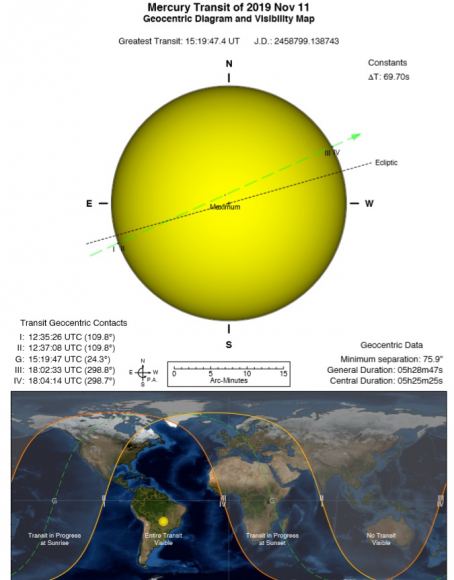
2019 contains a unique event: a rare 5 hour, 29 minute-long transit of Mercury across the visible disc of the Sun, visible from Europe, Africa, the Middle East and North/South America on November 11. This is only one of 14 transits of Mercury for the 21st century. The only total solar eclipse for the year occurs on July 2, crossing the South American Andes mountains through Chile and Argentina, passing directly over several major astronomical observatories.
A profound solar minimum is also expected in 2019 through 2020, as the Sun transitions from Solar Cycle #24 to Cycle #25.
–Meteor Showers: One of the best meteor showers starts off 2019, as the brief Quadrantids occur on (Jan 3) with a Zenithal Hourly Rate (ZHR)=100 while the Moon is a 5% illuminated, waning crescent. Other favorable showers for 2019 include:
-The Eta Aquarids (May 6) ZHR=50, Moon 4% illuminated, waxing crescent.
-The Daytime Arietids (June 7) ZHR=30, Moon 22% illuminated, waxing crescent.
-The Orionids (Oct 21) ZHR=20, Moon 49% illuminated, waning crescent.
-The Andromedids (Dec 3) ZHR=20, Moon 45% illuminated, waxing crescent.
-The Ursids (Dec 22) ZHR=50, Moon 14% illuminated, waning crescent.
–The Outer Planets in 2019: Mars does not reach opposition in 2019, but instead, spends most of the year low in the dusk sky, emerging into the early dawn in October. For the remainder of the outer planets, the best seasons centered on opposition are:
-Jupiter (June 10)
-Saturn (July 9)
-Uranus (Oct 28)
-Neptune (Sept 10)
-Pluto (Jul 14)
–The Inner Planets in 2019: Venus makes its best appearance early on in 2019, reaching maximum elongation on (Jan 6) 47 degrees west (dawn) of the Sun. Mercury reaches greatest elongation six times in 2019:
-Mercury (Feb 27), 18 degrees east (dusk).
-Mercury (Apr 11), 28 degrees west (dawn).
-Mercury (Jun 23), 25 degrees east (dusk).
-Mercury (Aug 9), 19 degrees west (dawn).
-Mercury (Oct 20), 25 degrees east (dusk).
-Mercury (Nov 28) 20 degrees west (dawn).
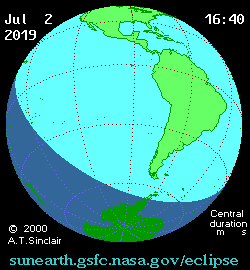
–Eclipses in 2019: There are 5 eclipses in 2019, 3 solar and 2 lunar:
-A partial solar eclipse (Jan 6) maximum totality of 71%, NE Asia and the N. Pacific.
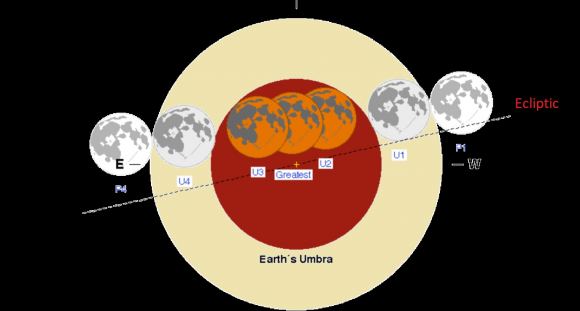
-A total lunar eclipse (Jan 21) totality duration 1 hour, 1 minutes favoring the Atlantic, North and South America.
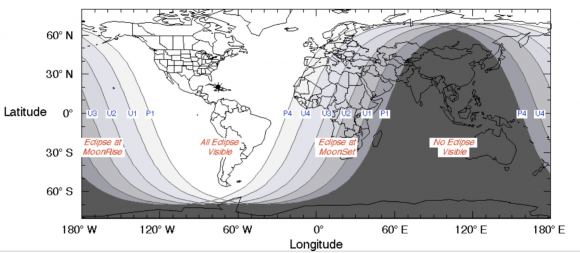
-A total solar eclipse (Jul 2), (maximum totality of 4 minutes, 33 seconds) covering the southern Pacific and Chile/Argentina.
-A partial lunar eclipse (Jul 16) 65%, favoring Africa, Europe, southern Asia and Australia.
-An annular solar eclipse (Dec 26) maximum annularity of 3 minutes 40 seconds covering South East Asia.
Transits: Mercury transits the disk of the Sun on (Nov 11).
Closest conjunctions in 2019: planet-planet: Mercury-Mars (June 18), 12′ apart, 24 degrees from the Sun in the dusk sky).
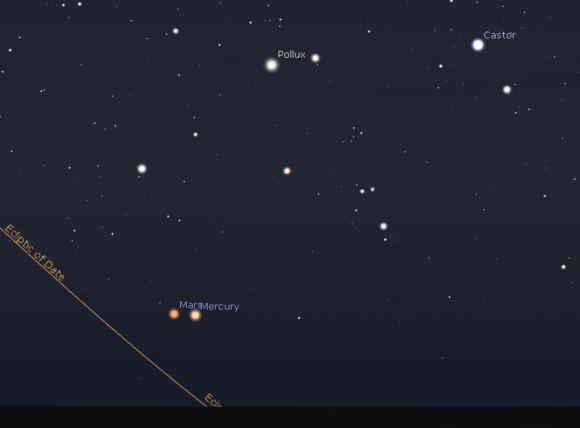
-Planet-star: Mars-Regulus (Aug 18, 38′ apart, 5 degrees from the Sun in the dusk sky).
Occultations of Planets in 2019: There are 20 occultations involving the Moon and five planets in 2019 (Note + means waning, – means waning):
-Mercury (1): Feb 5, Southeast Asia, +0.2% Moon.
-Venus (3): Jan 31, Central Pacific, -18% Moon, Dec 29, Antarctica, +10% Moon, Jul 31, -1% Moon.
-Mars (1) Jul 4, Central Pacific, -3% Moon.
-Jupiter (2) Nov 28, S. central Asia, +3% Moon, Dec 26, SE Asia, +0.1% Moon.
-Saturn (13) Jan 5, N America -0.1% Moon, Feb 2, N. Africa, -5.7% Moon, Mar 1 Central Pacific, -23% Moon, Mar 29, S. Africa -39% Moon, Apr 25, New Zealand SE Australia, -66% Moon, May 22, South Africa -88% Moon, Jun 19, S. South America, -96% Moon, Jul 16, South America, +99% Moon, Aug 12, Australia S. Pacific 91% Moon, Sep 8, SE Asia +72% Moon, Oct 5, South Africa, +46% Moon, Nov 2, New Zealand +30% Moon, Nov 29, S Atlantic, +9% Moon, Dec 27, Antarctica, +1% Moon.
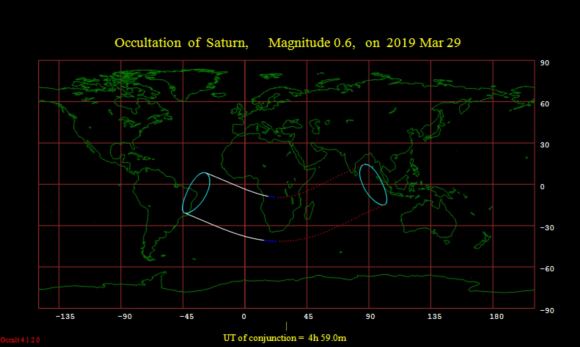
–Best occultation (star): The Moon does not occult a +1 magnitude or brighter star in 2019.
–Best asteroid occultation for 2019: Asteroid 678 Fredegundis occults the +4.9 magnitude star HIP 9153 (itself a wide double star) on October 31st, 2019 along a path crossing Eastern Australia.
Comet Prospects for 2019 – Periodic Comets over magnitude +10: 289P/Blanpain (perihelion Dec 21, mag. +6?) discovered in 1819, will only be favorable if it provides a surprise outburst.
-322P/SOHO (perihelion Aug 31, mag. +7). 322P is SOHO’s first periodic comet discovery.
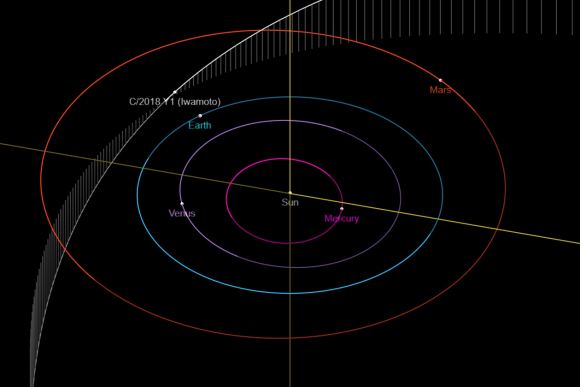
Comet updates:
-C/2018 Y1 Iwamoto- Discovered in December 2018, Comet Y1 Iwamoto will pass 0.2 AU from the Earth in early February, and top out at +7th magnitude.
Moon phases and phenomena for 2019:
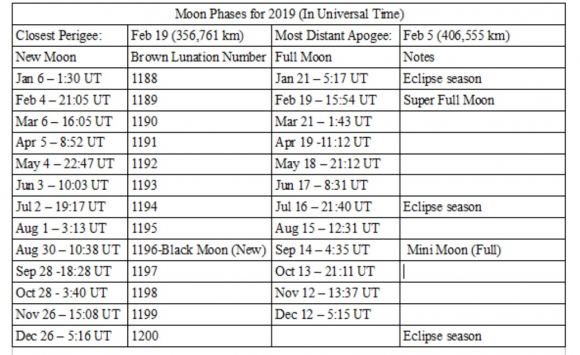
…And those are just the predicted events for 2019. Bright comets appear, meteor showers burst forth with greater activity than anticipated, and aurora and solar activity can always flare up unannounced. Watch the skies, and keep an eye on these pages as we write about these and other upcoming events for Universe Today.

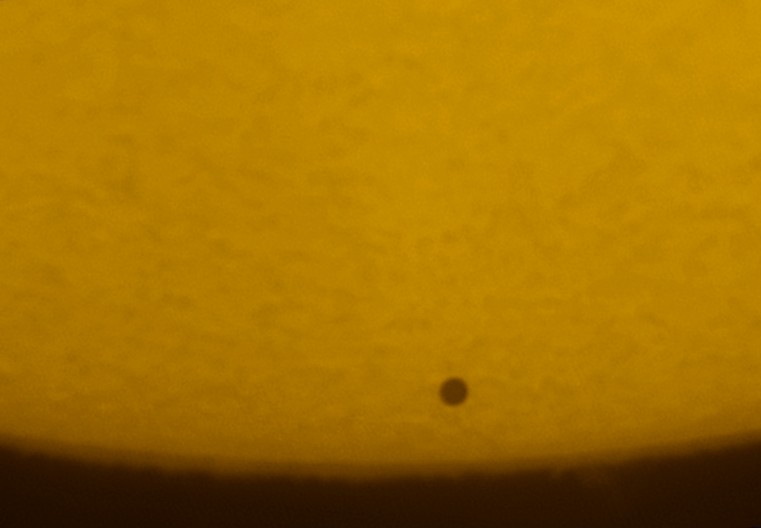
The book is great Dave, Fraser. Looking forward to the next edition.